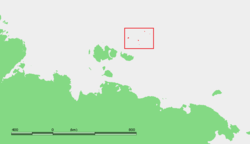Vilkitsky Island (East Siberian Sea)
- For other islands and geographic features called "Vilkitsky" see Vilkitsky (disambiguation).
Vilkitsky Island (Russian: Oстров Вильки́цкого; Ostrov Vilkitskogo) is the southernmost island of the De Long group in the northern part of the East Siberian Sea. At barely 1.5 km sq it is the smallest island of the group. Highest elevetion is 70 meters.[1] It is also outside of the limits of permanent ice and is unglaciated. Vilkitsky Island consists of deeply eroded nepheline basalt lava flows[2]
Administratively Vilkitsky Island belongs to the Sakha Republic administrative division of the Russian Federation.[3]

This island should not be confused with Vilkitsky Island in the Kara Sea, with the Vilkitsky island group (now mentioned as Dzhekman Islands in most maps) which is part of the Nordenskjold Archipelago in the Kara Sea, or with the Vilkitsky Island located in the Laptev sea off the eastern shores of the Taymyr Peninsula.
All these islands are named after Russian hydrographer Boris Vilkitsky.
History
Vilkitsky Island was discovered in 1913 during the Imperial Russian Arctic Ocean Hydrographic Expedition led by Boris Vilkitsky on the ships Taymyr and Vaygach.[4]
References
- ↑ Headland, R. K. (1994): OSTROVA DE-LONGA ('De Long Islands')
- ↑ Fujita, K., and D.B. Cook, 1990, The Arctic continental margin of eastern Siberia, in A. Grantz, L. Johnson, and J. F. Sweeney, eds., pp. 289-304, The Arctic Ocean Region. Geology of North America, vol L, Geological Society of America, Boulder, Colorado.
- ↑ Respublika Sakha (Yakutiya) Land Feature Database
- ↑ Starokadomski, L.M. and O.M. Cattley, 1919, Vilkitski's North-East Passage, 1914-15. The Geographical Journal. vol. 54, no. 6, pp. 367-375.
External Web Pages
- Anisimov, M.A., and V.E. Tumskoy, 2002, Environmental History of the Novosibirskie Islands for the last 12 ka. 32nd International Arctic Workshop, Program and Abstracts 2002. Institute of Arctic and Alpine Research, University of Colorado at Boulder, pp 23–25.
- Schirrmeister, L., H.-W. Hubberten, V. Rachold, and V.G. Grosse, 2005, Lost world - Late Quaternary environment of periglacial Arctic shelves and coastal lowlands in NE-Siberia. 2nd International Alfred Wegener Symposium Bremerhaven, October, 30 - November 2, 2005.
Coordinates: 75°42′N 152°30′E / 75.700°N 152.500°E